|
Tools for Every Use
by
Bob Brooke
By necessity, early settlers were jacks
of all trades. They had to be in order to survive. Not only did they
have to be tillers of the soil, but often carpenters, cobblers, coopers,
blacksmiths, and butchers. Each of these jobs required a different set
of tools, so the number of antique tools available to collectors is
quite large indeed.
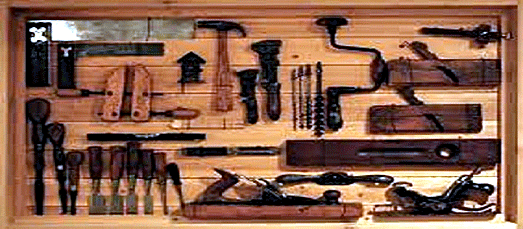
Often settlers had to make their own
tools. Back in the late 18th and early 19th century, the Sears Catalog
and others like it hadn’t even been thought of as yet. To satisfy their
needs, settlers developed a variety of useful tools to suit the job at
hand. If a farmer needed a pitchfork or a spade, he often fashioned it
himself using only a piece or two of wood, his penknife and an axe.
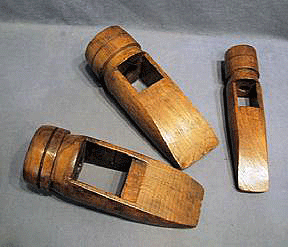 Old
tool collecting is relatively wide-spread and long established.
Amazingly countless men are serious tool collectors without realizing
it, because few discard old tools no matter how worn or obsolete they
have become. Old
tool collecting is relatively wide-spread and long established.
Amazingly countless men are serious tool collectors without realizing
it, because few discard old tools no matter how worn or obsolete they
have become.
Collectors search shows and flea market sales for huge augers used for
drilling holes in beams into which pegs are driven to join two timbers,
broadax-es and adzes used for hewing and finishing the beams, wooden
planes made to shape various molding designs, huge six-foot saws with
inch-long teeth used to cut ice from frozen lakes and ponds.
Blacksmiths' tools are also desired and a variety of specialized shapes
of hammers can still make an attractive collection.
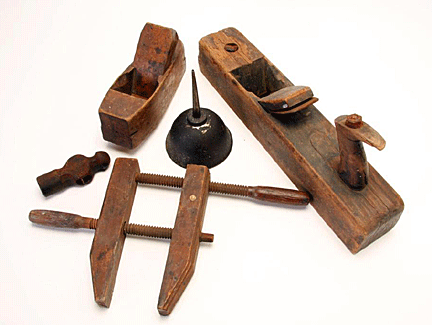 Collectors
especially favor those tools made to do jobs that are no longer needed.
The ice saw is one such example, as is the "traveler," a calibrated
circle mounted on a handle that settlers used to measure the
circumference of wagon wheels in order to fit them with a new iron tire. Collectors
especially favor those tools made to do jobs that are no longer needed.
The ice saw is one such example, as is the "traveler," a calibrated
circle mounted on a handle that settlers used to measure the
circumference of wagon wheels in order to fit them with a new iron tire.
Hand tools—particularly woodworking tools---are the most widely
collected. Collectors, most of whom are men, familiarize themselves with
specific tool designs early on. They learn to identify distinct changes
in tool design over the years. Some even specialize in one type of tool,
collecting all of its variations over time.
Of the manufactured tools, folding rulers and woodworking planes, such
those produced by the Stanley Tool Company after the mid 19th century,
are particularly popular. Beginning tool collectors shouldn’t forget
that often the toolbox, itself, with its fine dovetailing and
well-crafted, smoothly sliding trays, may be of considerable value.
How Do Collectors Choose Which Tools to
Collect
How people collect tools is largely a matter of personal choice. Many
collect cover a broad, general spectrum, while others prefer to
specialize in one or several types of tools, or tools related to a
particular period, geographic region, craft or trade or manufacturer.
Some collect only primitive wooden items, such as coach-men's tools,
coopers' tools, etc.; some try to limit their specialty to the simple,
plain, utilitarian wrought-iron tools characteristic of the Early
American period, many of them handmade by itinerant blacksmiths
traveling from farm to farm.
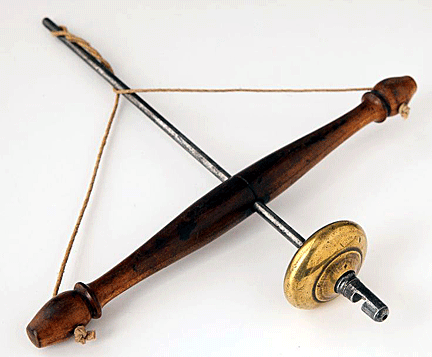 Over
the centuries, people hand down tools from generation to generation
until they finally find their way into a yard sale or a dealer's
inventory. The market is rich in relatively in-expensive collectors'
tools, but the advanced collector looking for pieces from a specific
period or of a particular type must approach specialty dealers or
advertise his requirements in an appropriate periodical or online. Over
the centuries, people hand down tools from generation to generation
until they finally find their way into a yard sale or a dealer's
inventory. The market is rich in relatively in-expensive collectors'
tools, but the advanced collector looking for pieces from a specific
period or of a particular type must approach specialty dealers or
advertise his requirements in an appropriate periodical or online.
So how do collectors value tools? The range of tool values is as wide as
the prices paid for them. Age, scarcity, materials - such as ivory or
ebony - and even beauty of workmanship all play parts in setting the
price for an item. Some antique tools have sold for as much as $8,000!
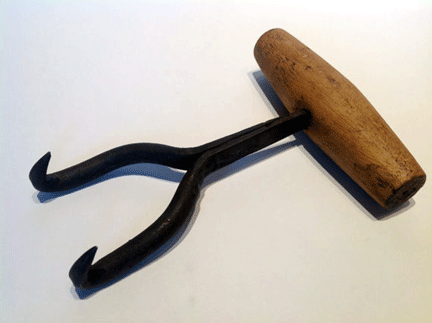 One
of the most intriguing challenges for the tool collector is identifying
the original purpose of an obsolete item. Who would guess, for instance,
that an odd-looking, forceps-like contraption with a curved grip was a
hog-snouter—a device used to cut the snouts of swine in such a way that
would stop them from rooting. One
of the most intriguing challenges for the tool collector is identifying
the original purpose of an obsolete item. Who would guess, for instance,
that an odd-looking, forceps-like contraption with a curved grip was a
hog-snouter—a device used to cut the snouts of swine in such a way that
would stop them from rooting.
Tools, in themselves, have an honesty and economy of design that appeals
to a collector’s aesthetic sense. They’re simple, rugged, with only the
purpose for which they were intended dictating their form. Their
appreciation as part of our heritage is definitely increasing.
Types of Antique Tools to Collect
There are nine different tools that are the most common to collect. All
but three have to do with carpentry.
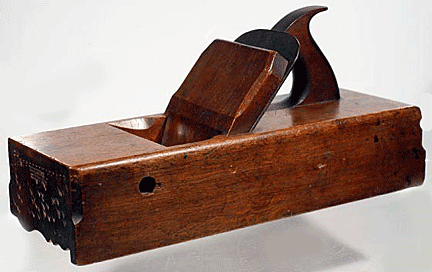 Planes
Wood planes are one of the most popular collectible hand tools around.
They are used to hold a chisel stationary so that the woodworker can
thin or shape boards of wood. Originally, many carpenters made their
planes themselves by purchasing blades from blacksmiths and carving
decorations or initials into the plane. Some of the most popular ones
include those made of Brazilian rosewood, beech, or birch with metal
surfaces made of brass and nickel embellished with exquisite details. Planes
Wood planes are one of the most popular collectible hand tools around.
They are used to hold a chisel stationary so that the woodworker can
thin or shape boards of wood. Originally, many carpenters made their
planes themselves by purchasing blades from blacksmiths and carving
decorations or initials into the plane. Some of the most popular ones
include those made of Brazilian rosewood, beech, or birch with metal
surfaces made of brass and nickel embellished with exquisite details.
Saws There are numerous styles of vintage saws, including those made by
Disston or Simonds, and Atkins. Collectors looks for those with handles
made from apple or beechwood. Rust-free blades that are straight are
also sought after.
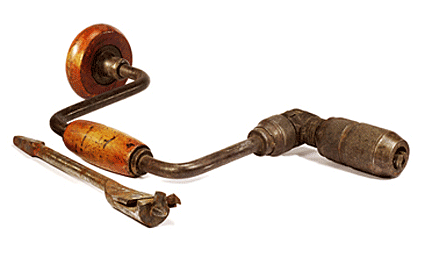 Hand
Drills Hand drills came in many different shapes, styles and varieties.
The most sought after are those with hollow wooden handles made to hold
bits, or those made out of wood with ivory used on the ends of the bit.
Some collectors prefer longer drills that have a brace with an auger or
twisted bit. Hand
Drills Hand drills came in many different shapes, styles and varieties.
The most sought after are those with hollow wooden handles made to hold
bits, or those made out of wood with ivory used on the ends of the bit.
Some collectors prefer longer drills that have a brace with an auger or
twisted bit.
Plumb Bobs A plumb bob is a weight that’s suspended from a line. Since
it hangs absolutely true, it allowed the user to find a true vertical,
especially those building houses or barns. Some antique plumb bobs come
in unusual shapes like pears, carrots, or turnips. Plumb bobs that are
of special interest to collectors include those crafted of precious
metals or inlaid with ivory or stones or those made from exotic woods or
brass or other metals that have been intricately covered with designs.
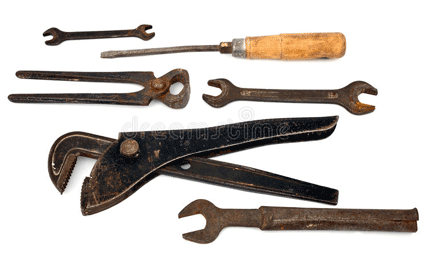 Wrenches
While wrenches and adjustable wrenches haven't changed much over the
years, the style of some older ones can make them highly collectible.
Collectors look for ones with rare cutout designs on the handles or
those with wooden handles. Wrenches
While wrenches and adjustable wrenches haven't changed much over the
years, the style of some older ones can make them highly collectible.
Collectors look for ones with rare cutout designs on the handles or
those with wooden handles.
Clamps Antique clamps come in a wide variety, including vise clamps and
blacksmith bench clamps.
Rulers Before the measuring tape, rulers were extremely important to
carpenters and builders. These long rules frequently were made to fold
in on themselves and store in unique ways that makes them collectable
now. Collectors especially favor Stanley's zig-zag rule that folds in 15
places or rulers that combined other tools such as compasses, levels or
squares.
Hammers
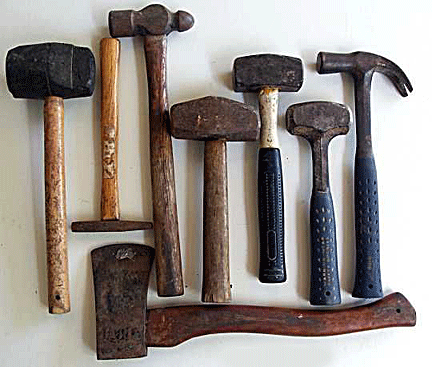 While
the use of hammers hasn't changed much over the years, the material and
shape of the hammers has. Collectors look for hammers made of different
materials like copper, lead, brass and wood, as well as three-piece
hammers that have a handle that comes apart for easier storage and those
with different, unique heads that combined a separate tool on the other
end. While
the use of hammers hasn't changed much over the years, the material and
shape of the hammers has. Collectors look for hammers made of different
materials like copper, lead, brass and wood, as well as three-piece
hammers that have a handle that comes apart for easier storage and those
with different, unique heads that combined a separate tool on the other
end.
Axes Edge tools like axes are one of the oldest known hand tools still
in existence. Some types that collectors look for are single and double
bit felling axes, broad axes, cooper's axes, and mast axes.
Chisels Antique chisels come in three types—woodworking, carpenters’,
and lathe. Collectors seek out those with wooden handles or with
specialty, curved blades.
Buying Antique Tools
The quality of a tool, and its usability is difficult to determine
remotely. So it’s almost imperative to shop for antique tools in person.
<
Back to Antiques Archives
Next Article > |
